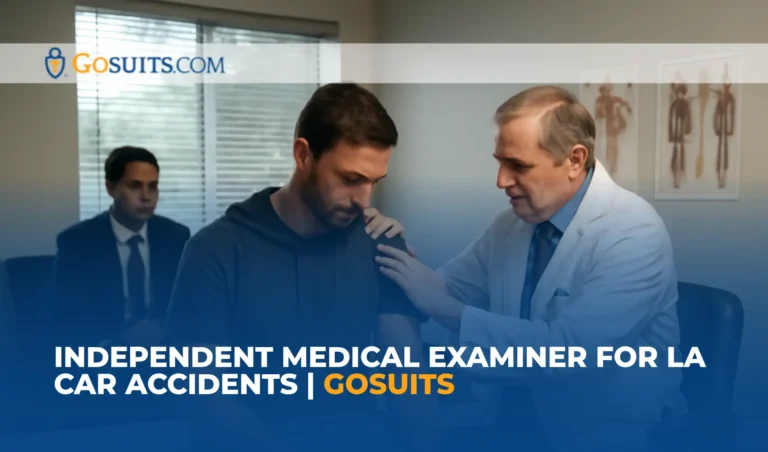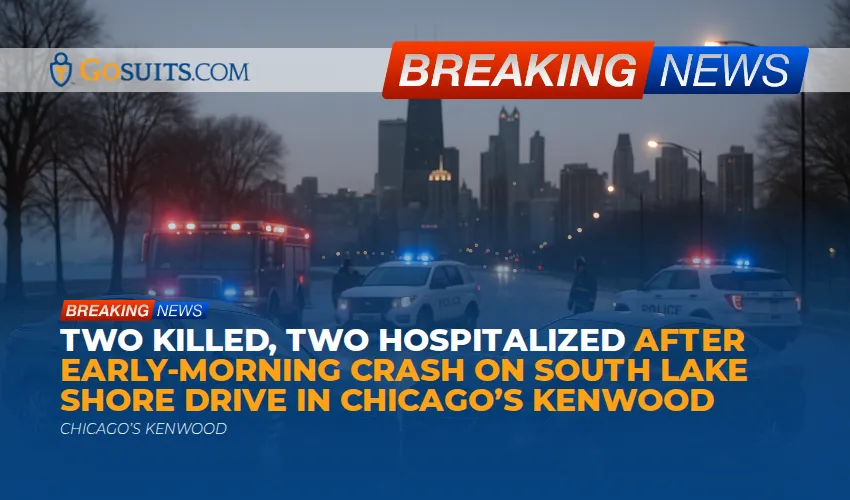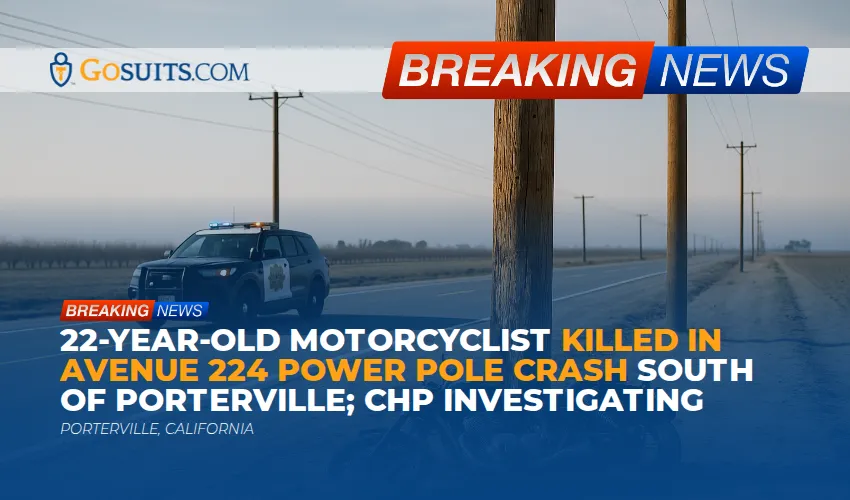- What is an independent medical examiner in a Los Angeles car accident case?
- When is an IME requested in an LA car accident claim?
- How does California law regulate medical examinations in civil cases?
- What should you expect before, during, and after an IME in Los Angeles?
- Can you bring someone, record the exam, or refuse parts of an IME in California?
- How do IME findings affect claim valuation and settlement negotiations?
- How do plaintiffs and defendants use IMEs differently in Los Angeles cases?
- Which injuries do IMEs commonly evaluate after LA car crashes?
- What records can IME doctors review, and how is your privacy protected?
- How can you challenge or clarify an unfavorable IME report?
- How are IME doctors chosen in Los Angeles County cases?
- What are the timing and scheduling rules for IMEs in California car accident lawsuits?
- How do federal court IME rules differ from California state court?
- Who pays for the IME and what are the typical costs?
- How do IMEs interact with treating physicians and second opinions?
- What statistics show the scope of car crash injuries in Los Angeles and the U.S.?
- What if injuries are disputed or symptoms are delayed after a crash?
- How can an accident lawyer in Los Angeles help you navigate an IME?
- What should you bring to an IME and how should you prepare?
- What mistakes should you avoid before and during an IME?
- Why GoSuits for Los Angeles car accident cases involving IMEs?
- Sources and references
What is an independent medical examiner in a Los Angeles car accident case?
An independent medical examiner in Los Angeles is a licensed physician who conducts a non-treating evaluation to provide an opinion about injuries, diagnoses, causation, need for treatment, and functional limitations after a car crash. In civil cases, this is often called a defense medical examination or insurance IME because the evaluation is usually requested and paid for by the defendant’s insurer. The doctor does not treat you; instead, the doctor examines, reviews records, and prepares a report used as evidence in a personal injury case. See a general definition at dictionary.law.com.
In Los Angeles car accident litigation, IMEs are common when the parties dispute whether the crash caused the injuries, how severe they are, what future care is needed, or whether the plaintiff can work. IME opinions can affect settlement negotiations, mediation, and trial strategy for both sides.
When is an IME requested in an LA car accident claim?
You might encounter an IME in several situations:
- Pre-lawsuit insurance claim: An auto insurer may ask for an “insurance IME” when you present a bodily injury claim. You are not automatically required to attend, but refusal can affect negotiations or policy conditions. A Los Angeles personal injury attorney can evaluate whether cooperation makes sense given your policy and facts.
- After filing a lawsuit: In California state court, defendants commonly demand a physical or mental examination when you claim ongoing bodily or cognitive injuries. Such examinations are governed by California discovery rules. See California Code of Civil Procedure discovery provisions on physical and mental examinations.
- Federal court cases in LA: If your case is in the Central District of California under federal jurisdiction, examinations are governed by Federal Rule of Civil Procedure 35, which authorizes a court-ordered physical or mental examination when your condition is in controversy and “good cause” exists. See Fed. R. Civ. P. 35.
How does California law regulate medical examinations in civil cases?
California law provides detailed rules for physical and mental examinations of a party whose condition is in controversy, typically in personal injury cases stemming from Los Angeles car accidents. Key points include:
- Scope and conditions are limited: Examinations are for discovery and must be limited to the condition in controversy. Parties can negotiate and courts can set protective conditions to prevent undue burden or intrusiveness. See Cal. Code Civ. Proc. §§ 2032.010–2032.650 (discovery act provisions on exams).
- Court supervision: If parties cannot agree on exam terms such as scope, duration, tests, or location, a court can issue an order specifying conditions. The Los Angeles Superior Court applies statewide law and its local rules to administer discovery disputes. See Los Angeles Superior Court local rules.
- Expert testimony framework: Opinions from IME physicians are subject to California Evidence Code rules on expert testimony. Expert opinions must be based on matter reasonably relied upon by experts and must assist the trier of fact. See Evidence Code § 801.
- Court-appointed experts: In rare situations, a court can appoint a neutral expert. See Evidence Code § 730.
While IME doctors are often selected by defense counsel or insurers, their testimony must still meet evidentiary standards. Courts can limit improper testing or require reporting protocols that promote fairness.
What should you expect before, during, and after an IME in Los Angeles?
What happens before the exam?
- Notice of exam: You receive written notice proposing the IME date, time, location, specialty, and scope. If details are missing or unreasonable, your lawyer can seek to negotiate or involve the court.
- Records review: The IME doctor may receive your medical records, imaging, billing, and prior injuries. Your attorney can review what is being sent and address overly broad requests.
- Transportation and accessibility: Exams are usually held in the doctor’s office around Los Angeles County areas such as Downtown LA, Pasadena, Santa Monica, Glendale, Long Beach, Beverly Hills, or West Hollywood. If travel is a hardship, your lawyer can ask for accommodations.
What happens during the exam?
- History: The doctor typically asks about the crash, symptoms, prior injuries, daily activities, and work. Answer truthfully and concisely. Avoid speculating.
- Physical or cognitive testing: Depending on alleged injuries, you may undergo range-of-motion testing, neurological checks, orthopedic maneuvers, or neuropsychological screening. Testing should be limited to the conditions at issue.
- No treatment: IME doctors do not provide treatment. They observe, test, and document.
What happens after the exam?
- Report: The IME doctor prepares a report with opinions on diagnosis, causation, impairment, need for care, and work restrictions.
- Disclosure: In litigation, the report is exchanged in discovery, so your side can analyze it, take the doctor’s deposition, and decide whether to settle or proceed to trial.
- Rebuttal: Your treating doctors or retained experts may respond with clarifications or contrary opinions.
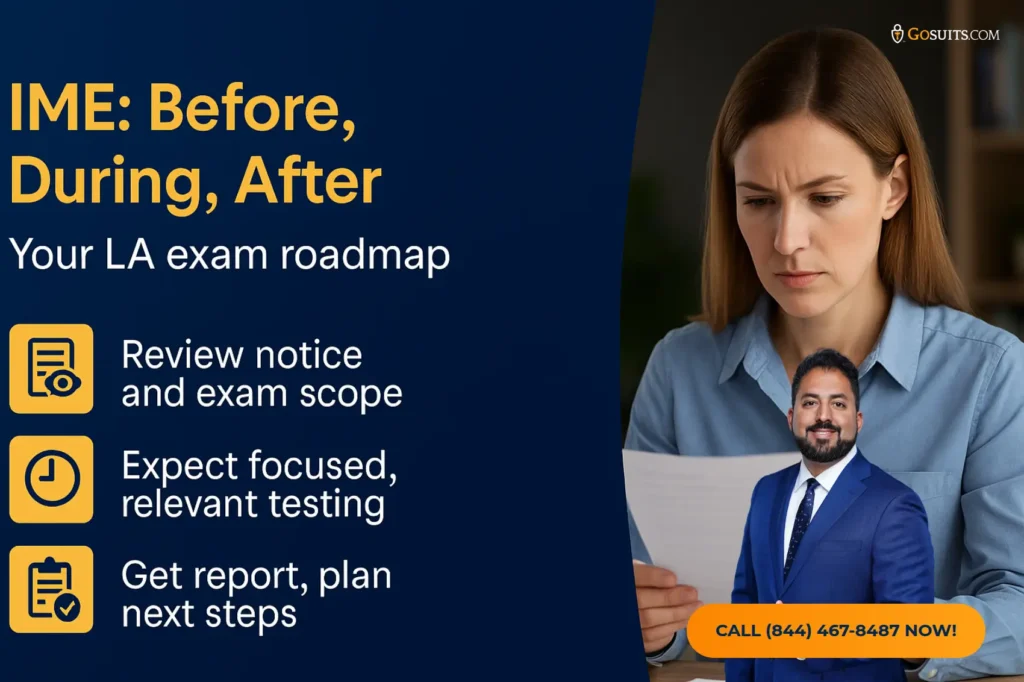
Can you bring someone, record the exam, or refuse parts of an IME in California?
Your rights and the exam conditions depend on California’s discovery statutes and any court order. Common issues include:
- Attendance: Whether a support person or attorney can attend often depends on the type of exam and any court-imposed conditions. Courts balance privacy, fairness, and the integrity of testing.
- Recording: Some examinations may be recorded by agreement or court order, particularly to preserve an accurate record of questions and testing. The rules differ for physical vs. mental exams and can be case-specific.
- Objections to invasive testing: Painful, intrusive, or risky testing can be limited or barred absent good cause. If a dispute arises, your attorney can seek a protective order.
Because these issues are technical and fact-specific, it is important to have legal counsel request protective conditions tailored to your medical situation. California’s discovery provisions allow courts to craft appropriate safeguards. See Cal. Code Civ. Proc. §§ 2032.010–2032.650.
How do IME findings affect claim valuation and settlement negotiations?
IME opinions can shift the value of a Los Angeles car accident case by influencing four core components:
- Causation: If the doctor links your injuries to the crash, it supports liability for bodily injury damages. If the doctor attributes symptoms to preexisting conditions, insurers may discount the claim.
- Severity and impairment: Range-of-motion loss, neurological deficits, or cognitive impairment can increase economic and non-economic damages, particularly when documented by objective tests.
- Future medical care: Opinions about surgeries, injections, physical therapy, or neurorehabilitation inform life-care plans and settlement ranges.
- Work capacity: Functional limits and restrictions affect lost wages and loss of earning capacity claims.
Both sides often use IME reports in mediation. Your attorney can counter with treating physician opinions, imaging studies, functional capacity evaluations, or a second medical opinion to reach a fair settlement.
How do plaintiffs and defendants use IMEs differently in Los Angeles cases?
- Plaintiffs: You may request a second medical opinion or an independent evaluation to build a clear, consistent medical narrative. Treating physicians can provide detailed causation and prognosis opinions. Plaintiffs also depose defense IME physicians to probe methodologies and assumptions.
- Defendants and insurers: Insurers use IMEs to test the claimed diagnosis, preexisting conditions, MMI (maximum medical improvement), return-to-work capacity, and reasonableness of past and future treatment. They may retain specialists such as orthopedists, neurologists, physiatrists, or neuropsychologists.
Judges in Los Angeles County expect both sides to exchange expert disclosures and comply with scheduling and discovery rules. See Los Angeles Superior Court local rules and statewide discovery statutes.
Which injuries do IMEs commonly evaluate after LA car crashes?
Common crash-related conditions evaluated in IMEs include:
- Whiplash and neck sprain-strain: Rapid acceleration-deceleration can injure the cervical spine. See MedlinePlus: Whiplash.
- Concussion and traumatic brain injury: Even without loss of consciousness, mild TBI can cause headaches, dizziness, memory issues, and mood changes. See CDC TBI Data.
- Orthopedic injuries: Shoulder rotator cuff tears, lumbar disc herniations, knee meniscal tears, and fractures often require orthopedic evaluation.
- Neurological deficits: Radiculopathy, neuropathy, or post-concussive syndrome may be assessed by neurologists.
- Chronic pain and functional impairment: Physiatrists or pain specialists may evaluate function, mobility, and need for interventional care.
What records can IME doctors review, and how is your privacy protected?
In California, discovery allows relevant records about the condition in controversy, subject to objections and protective orders. An IME physician may review:
- Post-crash treatment: ER notes, imaging, specialist visits, physical therapy, and prescriptions.
- Relevant prior records: If neck or back injuries are claimed, prior spine records may be discoverable to assess baseline conditions and causation.
- Billing and liens: Payment data can relate to reasonableness of charges.
Privacy is protected through rules on scope and court oversight. Health information might also be disclosed under HIPAA provisions that allow disclosures in response to a court order or subpoena with satisfactory assurances of privacy protections. See 45 C.F.R. § 164.512(e).
How can you challenge or clarify an unfavorable IME report?
If the IME doctor downplays your injuries or causation, your lawyer can take several steps in a Los Angeles car accident case:
- Deposition: Question the IME doctor about qualifications, testing methods, literature, time spent, alternative explanations, and any deviations from standard practice.
- Treating physician rebuttal: Obtain a detailed narrative report from your treating physician addressing causation, objective findings, and future care with medical reasoning.
- Independent evaluation: Seek a second opinion from a qualified specialist such as a spine surgeon, neurologist, or neuropsychologist.
- Evidentiary motions: Move to exclude improper opinions or limit testimony if the foundation is inadequate under California Evidence Code standards such as § 801.
- Life-care planning and FCE: Use a functional capacity evaluation or life-care plan grounded in treating records to counter claims of full recovery.
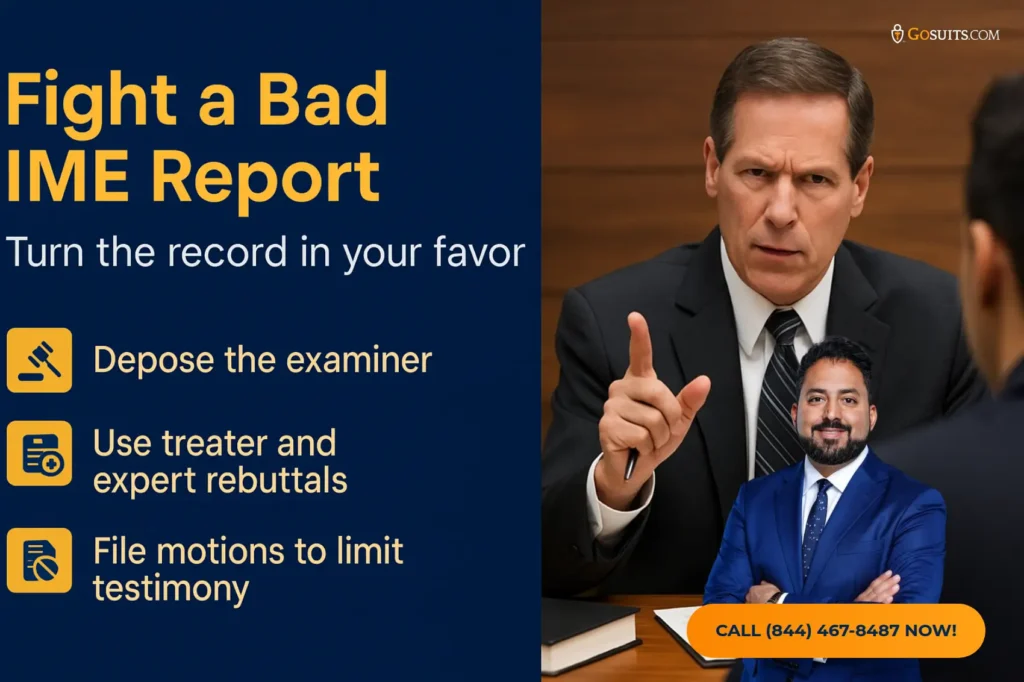
How are IME doctors chosen in Los Angeles County cases?
In practice, insurers or defense counsel select an IME physician with a relevant specialty. Plaintiffs can object to conflicts or inappropriate specialties, and courts can order a different examiner or impose conditions. In some cases, the court may appoint a neutral expert under Evidence Code § 730. Selection should consider proximity within Los Angeles County, the physician’s board certification, and experience with the alleged conditions.
What are the timing and scheduling rules for IMEs in California car accident lawsuits?
California’s discovery statutes govern who may demand an exam, how notice is given, and when exams occur during the discovery period. Parties typically coordinate dates to meet case management deadlines set by the Los Angeles Superior Court, including expert exchange and trial readiness milestones. If disputes arise, a motion can be filed to compel or to seek a protective order. See Cal. Code Civ. Proc. discovery provisions and LA Superior Court local rules.
California’s statute of limitations for personal injury is generally two years from the date of injury. Timely filing protects your right to discovery, including any necessary examinations. See Cal. Code Civ. Proc. § 335.1.

How do federal court IME rules differ from California state court?
Key differences when a Los Angeles car accident case is in federal court:
- Good cause requirement: Federal Rule of Civil Procedure 35 requires the requesting party to show good cause and that the condition is in controversy. See Fed. R. Civ. P. 35.
- Court order: Exams are authorized by court order in federal court, which sets time, place, manner, conditions, and scope.
- Local practice: The Central District of California may have scheduling orders and local practices that affect expert discovery timelines.
Who pays for the IME and what are the typical costs?
In insurance IMEs, the insurer typically pays. In litigation, the requesting party usually pays the examiner’s fees and associated costs. Fees vary by specialty and complexity. If travel or missed work is involved, counsel can address reasonable accommodations or seek cost-shifting through court orders in appropriate circumstances.
How do IMEs interact with treating physicians and second opinions?
Treating physicians focus on your care, while IME doctors provide litigation-focused assessments. When the IME differs from your treater’s opinion, counsel may:
- Clarify treating records: Obtain addendum reports tying imaging and exam findings to the collision.
- Second medical opinion: Get a concurring evaluation by a specialist in the LA area to add weight and objectivity.
- Objective testing: Use imaging, nerve studies, or neuropsychological testing to address causation or symptom validity concerns.
What statistics show the scope of car crash injuries in Los Angeles and the U.S.?
Traffic injuries are a significant public health concern in Los Angeles County and across the nation:
- Nationwide fatalities: NHTSA reports an estimated 42,514 people died in motor vehicle traffic crashes in 2022 in the United States. See NHTSA 2022 FARS data.
- TBI burden: The CDC reports about 223,000 TBI-related hospitalizations in 2019 and approximately 69,000 TBI-related deaths in 2021. See CDC TBI data.
- California insurance minimums: California mandates minimum auto liability insurance limits by statute, which influences available bodily injury liability coverage in many cases. See California Vehicle Code § 16056.
Local collision numbers and rankings are regularly analyzed by the California Office of Traffic Safety and state partners using SWITRS data. See California OTS.
What if injuries are disputed or symptoms are delayed after a crash?
Disputes often arise when symptoms appear days or weeks after a collision, or when imaging is initially normal. This is common with concussions, soft-tissue injuries, or aggravated degenerative conditions. Steps your legal team may take include:
- Thorough medical workup: Follow-up care, specialist referrals, and appropriate imaging can document evolving injuries.
- Functional documentation: Work notes, activity logs, and therapist records capture limitations that might not show on imaging alone.
- Targeted IME response: Request addenda from treaters or seek a focused second opinion to address disputed points raised in the IME.
How can an accident lawyer in Los Angeles help you navigate an IME?
IME strategy is a legal task that touches discovery rules, evidence standards, and negotiation leverage. A Los Angeles accident lawyer can:
- Limit scope and conditions: Negotiate exam parameters or seek a protective order if needed under California’s discovery provisions.
- Prepare you: Explain the process, help you organize records, and practice focused, accurate responses.
- Monitor fairness: Address logistics, language access, and disability accommodations in Downtown LA, Westside, San Fernando Valley, or South Bay locations.
- Analyze and rebut: Depose the IME doctor, challenge unsupported opinions, and amplify credible medical evidence.
- Use timing wisely: Coordinate the IME with mediation and expert disclosures to support settlement value or trial presentation.
Self-representation in cases involving IMEs carries risk because technical rules govern every step from scheduling to admissibility. Legal help is important to protect your rights.
What should you bring to an IME and how should you prepare?
A practical checklist for an IME in Los Angeles County:
- Identification: Government-issued ID.
- Medical summary: One-page list of diagnoses, surgeries, medications, allergies, and providers.
- Imaging and records: Only those your lawyer approves, if requested. Typically, records are sent in advance between counsel.
- Assistive devices: Braces, canes, TENS units, or orthotics you actually use.
- Accurate timeline: Key dates for crash, treatment milestones, time off work, and symptom changes.
- Attire and comfort: Clothing suitable for exam maneuvers; bring water and required medications.
Preparation tips:
- Be truthful and consistent: Inconsistencies harm credibility more than any single test result.
- Describe function, not conclusions: Explain what activities you can and cannot do and why.
- Avoid exaggeration: Provide specific, real-world examples of limitations at home, work, or school.
- Report baseline pain and flare-ups: Note frequency, duration, triggers, and relieving factors.
What mistakes should you avoid before and during an IME?
- Missing the appointment: No-shows can lead to court sanctions or claim delays. If you cannot attend, notify your attorney promptly.
- Discussing the case with the IME doctor: Answer medical questions but avoid legal argument or settlement talk.
- Giving incomplete history: Omitting prior injuries can damage credibility when records surface.
- Taking unapproved tests: If asked to undergo painful or invasive procedures, pause and contact counsel.
Why GoSuits for Los Angeles car accident cases involving IMEs?
If you were hurt in a Los Angeles crash and are facing an IME, a focused legal strategy makes a difference. GoSuits handles personal injury matters across Los Angeles County and Southern California, including Downtown LA, Santa Monica, Pasadena, Glendale, Long Beach, West Hollywood, and Beverly Hills.
- Aligned with your case needs: Car, rideshare, truck, pedestrian, bicycle, and scooter collisions frequently involve IMEs. A free consultation can help you understand the IME process, protect your rights, and plan next steps.
- Technology-driven representation: We use exclusive proprietary software to move cases faster, surface critical medical details early, and organize expert evidence for negotiations and trial.
- Innovation leadership: Our litigation workflows integrate medical timelines, imaging digests, and IME rebuttal modules designed to streamline discovery.
- Attorney access: Although we rely on technology to expedite your case, every client has a designated attorney. We do not use case managers, and you have direct access to your lawyer.
- Proven outcomes: See a sample of past results across LA-area courts at gosuits.com/prior-cases. Past results do not guarantee outcomes, but they show how thorough preparation and timely action can help.
- Experience that matters: Our team has 30 years of combined experience in personal injury litigation, including cases with complex IME, orthopedic, and neurocognitive issues.
- Trial-ready approach: We prepare cases for trial, which can strengthen your position during settlement talks. Trial experience helps us evaluate IME testimony, cross-examine medical witnesses, and present clear evidence to juries.
- Practice areas: Auto collisions, ride-hail crashes, commercial vehicle and delivery van crashes, pedestrian and bicycle injuries, premises incidents, and wrongful death.
We are available to discuss how an IME could affect your Los Angeles car accident case, what to expect, and how to prepare for a fair and thorough evaluation.
Sources and references
- Federal Rule of Civil Procedure 35 – Physical and Mental Examinations (Cornell LII)
- California Codes – Discovery Act provisions on physical and mental examinations (Cal. Code Civ. Proc. §§ 2032.010–2032.650)
- California Evidence Code § 801 (expert testimony)
- California Evidence Code § 730 (court-appointed experts)
- California Code of Civil Procedure § 335.1 (two-year statute of limitations for personal injury)
- California Vehicle Code § 16056 (financial responsibility – minimum liability coverage)
- 45 C.F.R. § 164.512(e) (HIPAA privacy rule – disclosures for judicial and administrative proceedings)
- California Office of Traffic Safety (statewide traffic safety data and resources)
- NHTSA: 2022 Traffic Fatalities (national statistics)
- CDC: TBI Data (TBI hospitalizations and deaths)
- MedlinePlus: Whiplash (NIH)
- Los Angeles Superior Court – Local Rules
FAQs specific to Los Angeles, California
Is an IME the same as a defense medical exam in California?
People often use the terms interchangeably. In litigation, California’s discovery statutes govern defense-requested physical and mental examinations of a plaintiff whose condition is in controversy. See Cal. Code Civ. Proc. §§ 2032.010–2032.650.

Do Los Angeles judges limit the number of IMEs?
Courts can limit the number, scope, and repetition of examinations to what is proportional and necessary. If multiple body systems are at issue, courts may allow more than one specialty. Disputes are resolved through motions and protective orders.
What if the IME is scheduled far from my neighborhood?
If you live in areas like Van Nuys, Inglewood, or East LA and the exam is set in Santa Monica or Beverly Hills, your attorney can request a more convenient location or reasonable accommodations based on your condition and transportation limitations.
Can a court appoint a neutral medical expert in LA?
Yes. In rare cases, a judge may appoint a neutral expert to assist the court or jury under Evidence Code § 730. This is separate from a defense-requested IME.
Will the IME doctor’s report be shown to a jury?
The report itself may be hearsay unless admitted under an exception, but the IME doctor can testify at deposition and trial. Admissibility and scope are governed by evidence rules, including Evidence Code § 801.
